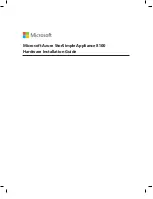
Introduction
6
Infoblox Installation Guide
Ethernet Port LEDs
To see the link activity and connection speed of an Ethernet port, you can look at its Link/Act and Speed LEDs.
Figure 3
LEDs
Connector Pin Assignments
An Infoblox appliance has three types of ports on its front panel:
•
USB port (reserved for future use)
•
Male DB-9 console port
•
RJ-45 10Base-T/100Base-T/1000Base-T auto-sensing fast Ethernet ports
The DB-9 and RJ-45 connector pin assignments are described in
Figure 4
. The DB-9 pin assignments follow the
EIA232 standard. To make a serial connection from your management system to the console port, you can use the
RJ-45 rollover cable and two female RJ-45-to-female DB-9 adapters that ship with the appliance, or a female DB-9-to-
female DB-9 null modem cable. The RJ-45 pin assignments follow IEEE 802.3 specifications.
10Base-T Ethernet and 100Base-T Ethernet use the same two pairs of wires. The twisted pair of wires connecting to
pins 1 and 2 transmit data, and the twisted pair connecting to pins 3 and 6 receive data. For 1000Base-T
connections, all four twisted-pair wires are used for bidirectional traffic. All Infoblox Ethernet ports are auto-sensing
and automatically adjust to standard straight-through and cross-over Ethernet cables.
MGMT and HA Ports
LAN Ports
Label
Color
Port Status
Label
Color
Port Status
Link/Act
Steady Orange
Link is up but inactive
Link/Act
Steady Green
Link is up but inactive
Blinking Orange
Link is up and active
Blinking Green
Link is up and active
Dark
Link is down
Dark
Link is down
MGMT, HA, and LAN Ports
Label
Color
Port Status
Speed
Steady Amber
1000 Mbps
Steady Green
100 Mbps
Dark
10 Mbps







































